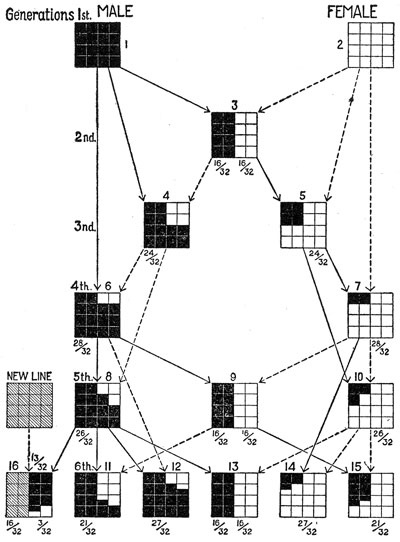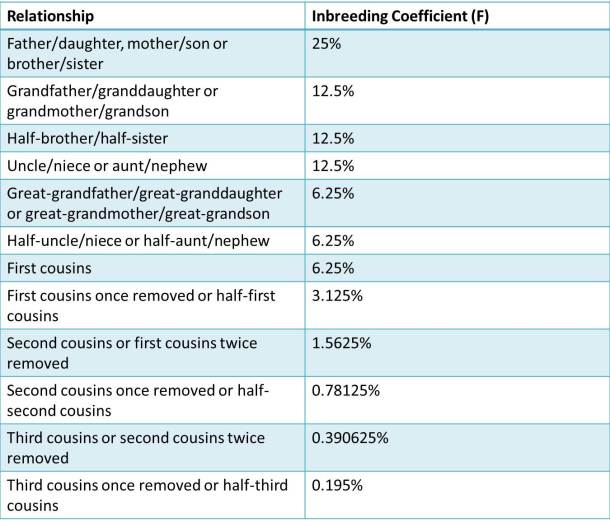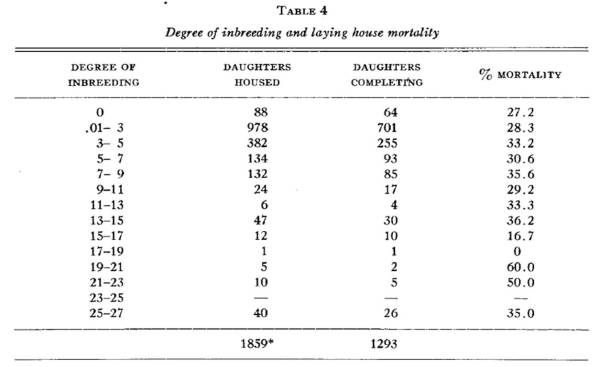Inbreeding Coefficients
Genetics Mini-Series Article #12
Humans have been keeping fowl for more than three thousand years1. All of the varieties of chickens and other poultry we see today were created by men to serve their purposes by the process of selective breeding. These birds were the best fit, not for their natural environment, but the artificial environment and expectations arising from their relationship with humankind.
Naturally, we have codified our breeding strategies as we learned what worked and what did not. As mentioned in the last genetics mini-series article, the basic concept has been to breed ‘the best to the best.’ In many breeding systems, this can lead to inbreeding and the appearance of a number of genetic weaknesses in the flock: curled toes, splayed legs, crooked beaks, difficulty hatching, etc. Inbred animals lack vigor and overall health. Over mankind’s many years of husbandry, we have learned that successful breeding programs maintain genetic diversity to the greatest extent possible.
Inbreeding can be calculated using a formula called the inbreeding coefficient. (You can read about this here and also here.) The inbreeding coefficient is used to calculate the likelihood of homozygosity in the offspring. The formula is complex and requires extensive information about the parentage of the birds going back several generations. (It can be approximated: “The inbreeding coefficient of an individual is approximately half the relationship (R) between the two parents.”2 The directions for calculating R are also somewhat complex and can be found here. Keep in mind that this approximation only works at relatively low-levels of inbreeding.)In a great post on the Backyard Chickens Forum, Allen W. Miller provided this list of inbreeding coefficients. (You can see the original post which includes great summaries of breeding systems as well.) If the parents aren’t already inbred (having a common ancestor), you can use the coefficients in the chart below.
Too much inbreeding leads to inbreeding depression. Basically, this is the opposite of hybrid vigor. Inbred animals are homozygous on too many alleles. They are less healthy and less productive.3 For example, Shoffner (1948, in F. M. Lancaster’s Genetic and Quantitative Aspects of Genealogy) found that, for every 10% increase in the inbreeding coefficient, chickens lost an average of 4.36% in egg hatchability and the capacity to produce 9.26 eggs per year. Even small increases in inbreeding can affect fertility, hatchability, and delay sexual maturation (Sewalem et al. in British Poultry Science, 1999, 40: 203–208).
Inbreeding has an even heavier impact on the immune system. Because MHC genes are responsible for identifying foreign invaders, we need a variety to catch all of the possible pathogens that can invade a body. Inbreeding reduces the diversity of MHC genes and, thus, directly affects our immune system’s ability to defend the body.4

This chart illustrates the genetic homogeneity resulting from breeding offspring back to the original sire or dam.
Many breeding systems seek to create “clones” because homogeneity within a flock is important for providing a consistent product, being eggs or meat, being able to approximate a flock’s yield, or ensuring a continued high level of performance in poultry shows. However, all of these come at a genetic cost. While some expert exhibition breeders are careful to maintain genetic diversity in their flocks, some are unable to do so perhaps due to limited stock availability such as occurs with threatened or endangered breeds. There are anecdotal reports of show flocks being wiped out by illness while the barnyard mutts survived. In a study on dogs, 3/4th of puppies with an inbreeding coefficient of 67% or higher died within ten days while surviving pups were severely impaired.
Diversity is strength: Where some may die, others may live. When inbreeding coefficients are too high, not only are there higher rates of recessive genetic problems, but everyone is susceptible to the same things. For a natural species, this means a very high chance of extinction. It’s not something nature favors, and nor should we.
Inbreeding is limited by increasing the number of ancestors whose genetic material is preserved in each generation. When the American Livestock Breeds Conservancy began to rebuild the Buckeye chicken breed, they maintained diversity by using the “Law of Ten” (here, scroll down to 4th page of PDF). They hatched many chicks, planning to keep only the top ten percent to improve the breed. However, rather than select the top ten percent of all offspring produced, they kept the top ten percent from each mating. Thus, the best that each bird could produce was kept, and the maximum number of ‘ancestors’ was maintained in subsequent generations.
![Walters Art Museum [Public domain, CC-BY-SA-3.0 (http://creativecommons.org/licenses/by-sa/3.0) or GFDL (http://www.gnu.org/copyleft/fdl.html)], via Wikimedia Commons](https://i0.wp.com/upload.wikimedia.org/wikipedia/commons/3/36/Ishiguro_Koreyoshi_-_Fuchi_with_Hen_and_Chicks_under_Pine_-_Walters_5111803A.jpg) This is the last article of the Scratch Cradle Genetics Mini-Series. However, there are many related topics I would still like to explore. Keep your eye out for “GMS Supplement” posts in the near future, and thanks for reading!
This is the last article of the Scratch Cradle Genetics Mini-Series. However, there are many related topics I would still like to explore. Keep your eye out for “GMS Supplement” posts in the near future, and thanks for reading!
![Niko Pirosmanashvili [Public domain], via Wikimedia Commons](https://i0.wp.com/upload.wikimedia.org/wikipedia/commons/8/8f/Pirosmani._Hen_with_her_chicks._Oil_on_oilcloth._Art_Museum_of_Georgia.jpg)
![See page for author [Public domain], via Wikimedia Commons](https://i0.wp.com/upload.wikimedia.org/wikipedia/commons/d/dc/PSM_V77_D207_Effects_of_inbreeding_and_crossbreeding_in_maize.png)




Thanks again for a well written, understandable post and series.
Thanks, Max! I just reworked this one a bit – it felt choppy to me – and I think it’s better now. Thank you so much for reading! I had a lot of fun.
Pingback: GMS Supplement #1: Recessive White « Scratch Cradle
You have taught me more in one night of reading your series than the many, many nights I spent with Crawford’s tome. Now I have the confidence to go back to it. Thank you!
That is awesome to hear! Thank you so much, Anne. I’m glad the series was helpful!